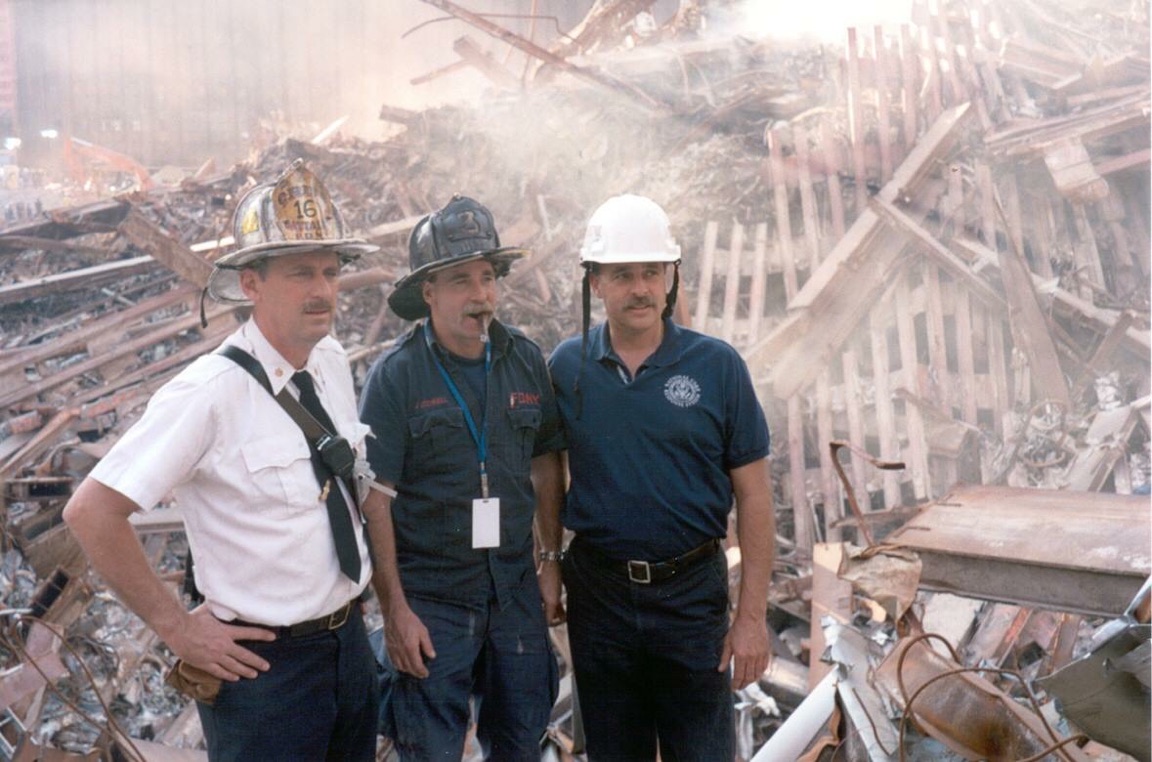
Left to Right: Member of NY Task Force 1 and FDNY Battalion Chief John Norman, Member of NY Task Force 1 and FDNY Firefighter John O’Connell and FEMA US&R Operations Section Chief for the WTC response Fred Endrikat.
The National Urban Search and Rescue Response System may have looked a little different on September 11, 2001, but its mission was the same: deploy search and rescue teams as fast as possible following a disaster. Fred Endrikat was one of the Urban Search and Rescue members that was called to action that day.
On the morning of 9/11, Endrikat received a call from FEMA Headquarters, asking him to deploy as the Operations Chief for the World Trade Center with the FEMA Urban Search and Rescue Incident Support Team. At the time, Endrikat was also serving as a member of FEMA US&R’s Pennsylvania Task Force One, as well as a member of the Philadelphia Fire Department.
This wasn’t his first deployment. “I had been a part of the Federal Urban Search and Rescue System pretty much since its inception,” Endrikat said. “I had deployed a number of times to different disasters that were primarily weather related. This one was different because of the type of incident that it was, but also I think, on a personal note, it was very different because a number of the people that were later determined to be lost at the World Trade Center were NYC firefighters who were personal friends of mine… so I was responding to an incident where I personally knew some of the victims.”
The morning Endrikat was called to action, he was transported from his home in Philadelphia by a Pennsylvania State Police car to McGuire Air Force Base in New Jersey. Once there, he began to set up a reception area for inbound federal task forces that were going to be arriving by military airlift. Later that afternoon, he was driven to the World Trade Center site. Discussions of response focused on the assignments and resources being requested by the City of New York.
The initial missions assigned to the task forces were technical search operations using specialized cameras and listening devices, as well as canine search operations. Members also performed physical void searches, which meant putting people into collapsed voids below grade to search for survivors.
“A tremendous amount of heavy steal columns that had collapsed or were holding up pieces of the collapsed voids of areas that we were interested in operating in, all had to be cut and rigged and moved with cranes,” he said.
Structural engineers that were members of the Urban Search and Rescue System and specifically trained in collapse rescue operations were an essential part of the response. The need to search effectively was also an opportunity for the teams to utilize new emerging technology in search operations.
“Overall the whole situation was very difficult to describe just because the size and the scope of it,” Endrikat said. “It was 16 acres of collapsed steel reinforced concrete buildings, which from the technical aspect of working was really daunting. Some of the challenges were not different from many of the disasters we respond to as an agency, but, on the other hand, some of them were more magnified.”
Communication was also a problem during this time because of the loss of life the New York City Fire and Police Departments faced, the need to adapt to the local systems in place for incident command and the amount of unrequested resources flooding into the city.
“Many people and many public safety personnel just wanted to help, so they just showed up. There was a huge challenge trying to manage all the people that wanted to help.”
He said that this desire to help brought the country together. “It demonstrated that we are capable of coming together, putting our resources, our talents and our energies together to try to affect the common good,” he said.
Endrikat believes that not just the country, but FEMA too was changed by what happened that day. “The magnitude of those incidents helped the agency determine the course that we’ve been on since that day and how we get better at helping people,” he said. “There was a focus on being prepared and figuring out how we can do better, starting at the local level, the regional level, the state level and the federal level, how we interact together. And how we can train, equip and sustain that type of capability. So that’s been the focus of my career for the past twenty years.”
Endrikat says he feels humbled and honored to be part of the initial operations, the recovery and the efforts to build on the lessons learned from that day. Today, he remains dedicated to being ready to serve.
“I think that really is the core value of the 6,000 members of the FEMA National Urban Search and Rescue Response System: their dedication, their service, their passion and their desire just to serve and to be ready,” he said.


